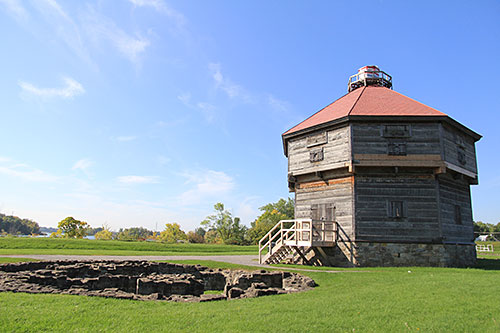Frequently asked questions
Coteau-du-Lac National Historic Site
Coteau-du-Lac
What does "Coteau-du-Lac" mean?
The name Coteau-du-Lac refers to the geographic features of the site. In French popular idiom of the time, "coteau" was used to denote a cluster of homes. The nearby location of Lake St. François explains the addition of "lac" to the name.
When did the current name appear for the first time?
The French named this location "Coteau-du-Lac" as far back as 1721. The habitation was raised to a parish only in 1832, however.
Canal-building
What is the total length of the St. Lawrence River?
From Lake Ontario to the Gaspé peninsula, the River covers a distance of 1 167 km.
How much does the St. Lawrence drop between the Great Lakes and Montréal?
The total drop is about 75 m.
Why have water levels gone down?
Water levels have decreased on account of canal-building, wide-scale deforesting, the drying up of brooks and streams and the building of hydroelectric dams, among other things.
A word about the "batteau"
The "batteau" (which in French was written with two t's at that time) offered greater cargo capacity than the canoe. It was used by the French for transporting material between Montréal and the Great Lakes outposts.
What did the "batteau" look like, you may well wonder. Although the size of individual boats could vary, "batteaux" of the type used on the upper St. Lawrence measured 9 to 12 m in length and 1.5 to 2.5 m in width, and offered a cargo capacity of 2 700 to 4 500 kg. It was a flat-bottomed boat that tapered to points at both ends.
Oars, for the most part, were used to manoeuvre the "batteau", but it could also be poled along. In the more open stretches of the river, a sail could be rigged as well. Crews of four to five men were required on board. Despite its advantages, the "batteau" nevertheless presented one major drawback: upon entering the "rigolet" canal, anywhere from 75% to 100% of the cargo had to be unloaded if the "batteau" were to clear the lock bottom.
Military history
What happened to the buildings?
Following sale of the Coteau property at the auction in 1872, buildings deteriorated owing to a combination of neglect and changes made to the site.
Did a battle take place at Coteau-du-Lac?
Although the Americans did attack Les Cèdres in 1776, Coteau-du-Lac was never the scene of any clash during the two Anglo-American wars. During the War of 1812, a battle was fought at Allan's Corner (in the Battle of the Châteauguay ), on October 26, 1813.
What does the word "blockhouse" mean?

The Oxford English Dictionary has defined this word as "a detached fort blocking or covering the access to a landing, a narrow channel, a mountain pass, a bridge or other strategic point [and later] an edifice of one or more storeys, constructed chiefly of timber, loop-holed and embrasured for firing." The word is probably of Dutch or German origin, but has been common in the English language since about 1 500. It has been argued that the "block" portion of the word originally referred to the obstruction of a passage and only later was associated with the squared logs of timber used to build such structures.
What was the blockhouse used for?
The octagonal shape of the blockhouse made it possible to keep watch over both the river and the site itself. A quick-firing, quick-loading cannon was strategically positioned on the second storey. This upper storey was intended to house 64 men rather than the actual 148. In 1815, the first floor was converted into a hospital. Later, it was used to accommodate canal workers.
Archaeology
Have digs been conducted over the entire site?
No. Archaeologists have only managed to survey a few parcels of site land. The Coteau-du-Lac site has undergone three major excavation campaigns. The first excavation, in 1965-1966, enabled archaeologists to study and excavate the vestiges (lock canal, defence buildings, lodgings and services, etc.) and the objects required for the site layout and for the heritage presentation (archaeological sector).
In 1968, following the discovery of palaeohistoric traces uncovered during the previous campaign, more in-depth research was done on the nature of the occupation.
Finally, in 1982, the last excavation sought to determine the archaeological potential of the sectors located outside the historic site's previously excavated zones.
Related links
- Date modified :